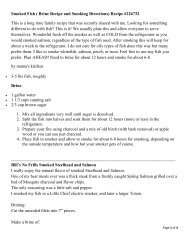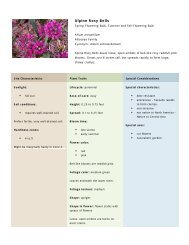You also want an ePaper? Increase the reach of your titles
YUMPU automatically turns print PDFs into web optimized ePapers that Google loves.
VINES-Most vines will grow best when allowed to climb up a vertical support. When<br />
planting a climbing vine near a building, fence, wall or tree, set the plant at least 18" from<br />
the structure which will support it. Then gradually train it to grow over to the structure.<br />
Garden arbors, trellises and similar supporting structures intended especially for vines<br />
usually are in the open. Prepare the soil as recommended, planting the vine close to the<br />
support. Do the same for mesh-type fencing.<br />
Don't let your vines form into a tangle. They should be pruned frequently through the<br />
summer, spreading and tying the shoots to keep them to a single "layer" over the support.<br />
Of the flowering vines, clematis is the first choice of the majority of American gardeners.<br />
A key essential to getting your clematis plants established is to make sure the root system<br />
will be kept cool. A sunny location where roots can grow under a cool covering, such as<br />
other perennials or mulch, is ideal. Deep planting-about a half inch deeper than it was<br />
grown in the nursery--encourages extra-strong root development and frequent, thorough<br />
watering will encourage vigorous growth.<br />
Soak roots for at least an hour before planting.<br />
BAREROOT TREES, SHRUBS AND HEDGES-There are six basic steps for planting<br />
trees, shrubs and hedges:<br />
1. Dig a hole large enough 10<br />
give the raots plenty of raom,<br />
with a few inches of space<br />
beyond the root tips and the<br />
sides of the hole. Build a mound<br />
of soil in the bottom of the hole<br />
and spread raots in a natural<br />
position atop the mound.<br />
4. Fill the planting hole<br />
with water and let it soak<br />
in. Straighten the plant in<br />
the hole and finish filling<br />
with soil.<br />
2. Position the plant so the<br />
previous soil line will be<br />
even with ground level. (The<br />
stem/trunk will be darker<br />
in color below the original<br />
planting line and lighter in<br />
color above it.)<br />
5. Form a "saucer" of soil<br />
around the edges of the<br />
planting hole and fill it with<br />
water. (To promote growth,<br />
dig four small holes, 4-6"<br />
deep, around the perimeter<br />
of the planting hole and drop<br />
a Power Pill in each hole.<br />
[See back cover for information<br />
on Power Pills.})<br />
PAGE 7<br />
3. Once the plant is positioned<br />
at the proper planting<br />
depth, begin filling the<br />
hole with soil. Work the soil<br />
around the roots with your<br />
hands. When the hole is<br />
half filled, tamp the soil to<br />
remove any air pockets.<br />
6. The lower trunk of newly<br />
planted trees should be<br />
wrapped with heavy paper<br />
or special tree wrap from a<br />
local garden supply store.<br />
This will protect tender bark<br />
from sunscald and rodents.<br />
A cylinder of screen wire is<br />
useful to protect the trunk<br />
from destructive animals.












